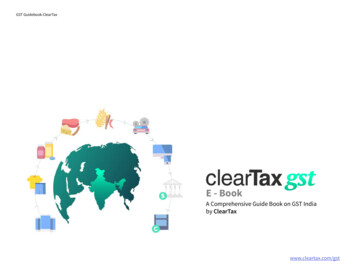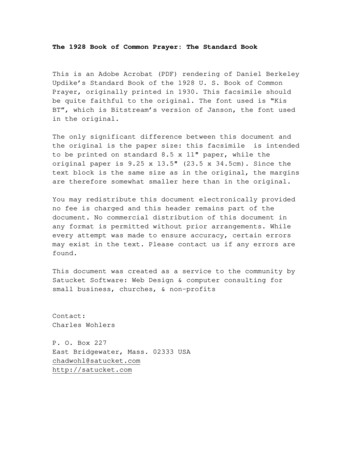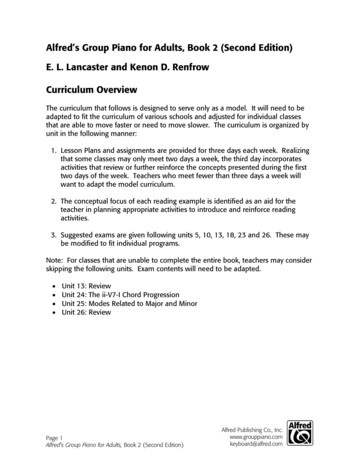
Transcription
GST Guidebook-ClearTaxfor Reckitt BenckinserE - BookA Comprehensive Guide Book on GST Indiaby ClearTaxwww.cleartax.com/gst
GST Guidebook-ClearTaxfor Reckitt BenckinserGST in INDIA - A Comprehensive Guide Bookby ClearTaxGST is a huge reform for indirect taxation in India, the likes of which the countryhas not seen post Independence. GST will simplify indirect taxation, reduce complexities, and remove the cascading effect. Experts believe that it will have a huge impacton businesses both big and small, and change the way the economy functions.This ebook will help you understand the basics of GST, important terminologies andconcepts, and how this might affect your business in the long run. Students of finance,business professionals, entrepreneurs, tax practitioners and accountants will find thise-book comprehensive and helpful in understanding GST.00www.cleartax.com/gst
GST Guidebook-ClearTaxContentfor Reckitt Benckinser1. GST vs the Current Indirect Tax Structure2. Why is GST a big deal?India’s largest Tax Technology PlatformAutomate reconciliationsExpedite action itemsAutomate Input Tax Credit ManagementAvoid human errors3. Time, Place, and Value of Supply4. Registering under GST5. GST Returns-How and When to File Them6. Mixed Supply and Composite SupplySimple integration with existing systems7. Composition LevySimplify GST for your team8. What is Aggregate TurnoverSecure, with 100% uptime9. Input Tax Credit in Detail10. Reverse Change11. What is GST Compliance Rating?12. Impact of GST on Manufacturers and FMCG industrywww.cleartax.com/gstwww.cleartax.com/gst
GST Guidebook-ClearTaxfor Reckitt Benckinser1.GST VS CURRENT INDIRECT TAX STRUCTURETo understand GST, it is important that we understandthe current indirect taxation system. Direct taxes such asincome tax are borne by the person liable to pay the tax;this means that the tax burden cannot be shifted to anyone else. The liability of an indirect taxes on the other hand,can be shifted to another person. So, the person liable to paythe tax can collect the tax from someone else and then pay itto the government; thus shifting the tax burden. The GST taxfalls in this category.The current indirect tax structure, which comprises of somany different taxes, can be classified as:Central taxes: levied by the Central govt (includes CentralSales Tax, Excise Duty etc.)State taxes: levied by the various state govts (VAT, ServiceTax, Octroi)The current indirect tax has one major problem the casacading effect. When you buysomething, you pay atax on tax itself.Let’s understand this with a hypothetical numericalexample02INDIRECT TAXCENTRAL TAXSTATE TAXExcise TaxEntry TaxService TaxVAT/CST TaxCustoms TaxTax on LotteryLuxury TaxAdvert. Taxwww.cleartax.com/gst
GST Guidebook-ClearTaxfor Reckitt BenckinserSTAGE 1Say a shirt manufacturer pays INR 100 to buy raw materials.If the rate of taxes is set at 10%, and there is no profit or lossinvolved, then he has to pay INR 10 as tax. So, the final costof the shirt now becomes INR (100 10 ) 110.STAGE 2At the next stage, the wholesaler buys the shirt from themanufacturer at INR 110, and adds labels to it. When he isadding labels, he is adding value. Therefore his cost increases by say INR 40. On top of this, he has to pay a 10% tax, andthe final cost therefore becomes INR (110 40 ) 150 10%tax 165.STAGE 3Now, the retailer pays INR 165 to buy the shirt from thewholesaler because the tax liability had passed on to him. Hehas to package the shirt, and when he does that, he is addingvalue again. This time, let’s say his value add is INR 30. Nowwhen he sells the shirt, he adds this value plus the VAT he hasto pay the government to the final cost. So the cost of theshirt becomes INR 214.5 Let’s see a breakup for this:Cost INR 165 Value add INR 30 10% tax INR 195 INR 19.5 INR 214.503So, the customer pays INR 214.5 for a shirt the cost priceof which was basically only INR 170. Along the way the taxliability was passed on at every stage of transaction and thefinal liability comes to rest with the customer. This is calledthe Cascading Effect of Taxes where a tax is paid on tax andthe value of the item keeps increasing every timethis happens.ActionCost10% Tax TotalBuys Raw Material10010110Manufactures @ 4015015165Adds Value @ 3019519.5214.5Total17044.5214.5GST aims to solve this problem by introducing seamless Input Tax Credit (ITC). Today, the tax that you payon material purchases cannot be claimed from outputtax. This is set to change with ITC.www.cleartax.com/gst
GST Guidebook-ClearTaxfor Reckitt BenckinserIn our example, when the wholesaler buys from the manufacturer, he pays a 10% tax on his cost price because theliability has been passed on to him. Then he adds valueof INR 40 on his cost price of INR 100 and this brings up hiscost to INR 140. Now he has to pay 10% of this price to thegovernment as tax. But he has already paid one tax to themanufacturer. So this time what he does is, instead of payingINR (10% of 140 ) 14 to the government as tax, he subtractsthe amount he has paid already. So he deducts the INR 10he paid on his purchase from his new liability of INR 14, andpays only INR 4 to the government. So the INR 10 becomeshis input credit.When he pays INR 4 to the government, he can pass on its liability to the retailer. So, the retailer pays INR (140 14 ) 154to him to buy the shirt. At the next stage, the retailer addsvalue of INR 30 to his cost price and has to pay a 10% tax onit to the government. When he adds value, his price becomesINR 170. Now, if he had to pay 10% tax on it, he would passon the liability to the customer. But he already has inputcredit because he has paid INR 14 to the wholesaler as thelatter’s tax. So, now he reduces INR 14 from his tax liabilityof INR (10% of 170 ) 17 and has to pay only INR 3 to thegovernment. And therefore, he can now sell the shirt for INR(140 30 17) 187 to the customer.04ActionCost10% Tax Actual Liability TotalBuys Raw Material1001010110Manufactures @ 40140144154Adds Value @ 30170173187Total17017187In the end, every time an individual was able to claim input tax credit, the sale price for him reduced and the costprice for the person buying his product reduced becauseof a lower tax liability. The final value of the shirt alsotherefore reduced from INR 214.5 to INR 187, thus reducingthe tax burden on the final customer.So essentially, GST is going to have a two-pronged benefit.One, it will reduce the cascading effect of taxes, and second,by allowing input tax credit, it will reduce the burden of taxesand, hopefully, prices.www.cleartax.com/gst
GST Guidebook-ClearTaxfor Reckitt Benckinser2.SO, WHY IS GST A BIG DEAL?GST is a comprehensive, multi-stage, destination-basedconsumption tax on levied at every stage of value additionin the lifecycle of a product. To understand this better, let uslook at each of the terms in detail:Comprehensive: GST will subsume all of the currentindirect taxes. Plus, by bringing in a unified taxationsystem, across the country, it will ensure that there isno more arbitrariness in tax rates.Multi-stage: GST is levied each stage in the supplychain, where a transaction takes place.Value-addition: This is the process of addition to thevalue of a product/ service at each stage of its production, exclusive of initial costs. Under GST, the tax islevied only on the value added. This is done through05Destination-based consumption: Unlike the currentindirect taxes, GST will be collected at the point ofconsumption. The taxing authority with appropriatejurisdiction in the place where the goods/ services arefinally consumed will collect the taxFor example: Let’s say that cotton garments are being shippedfrom Karnataka to Maharashtra. Karnataka is the producer stateand Maharashtra is the consumer state. Tax revenue under GSTLet’s understand how this will impact imports and exports.Exports are not taxable, because the place of consumptionis outside India. Imports are taxable, because the place ofconsumption is in India.The tax on imported goods will therefore be just thesame as domestically-produced goods. Imports would becostlier because of additional custom duties. Thus, theexport industry will become more competitive. Also, domestic goods will be protected by making imports at par withdomestic goods.www.cleartax.com/gst
GST Guidebook-ClearTaxfor Reckitt BenckinserWHAT IS SGST, CGST, AND IGST?Suppose goods worth INR 10,000 are sold by manufacturer Ain Maharashtra to Dealer B in Maharashtra. B resells them totrader C in Rajasthan for INR 17,500. Trader C finally sells toEnd User D in Rajasthan for INR 30,000.Suppose CGST 9%, SGST 9%. Then, IGST 9 9 18%Since A is selling this to B in Maharashtra itself, it is an intra-state sale and both CGST and SGST will apply, at therate of 9% each.B (Maharashtra) is selling to C (Rajasthan). Since it is an interstate sale, IGST at the rate of 18% will apply.C (Rajasthan) is selling to D also in Rajasthan. Once again itis an intra-state sale and both CGST and SGST will apply, atthe rate of 9% each.06*** Any IGST credit will first be applied to set off IGSTthen CGST. Balance will be applied to setoff SGST.Since, GST is a consumption based tax, i.e., the state wherethe goods were consumed will collect GST. By that logic, Maharashtra (where goods were sold) should not get any taxes.Rajasthan and Central both should have got (30,000 * 9%) 2,700 each instead of only 2,250.Maharashtra (exporting state) will transfer to the Centre thecredit of SGST of INR 900 used in payment of IGST.The Centre will transfer to Rajasthan (importing state)INR 450 as IGST credit used.**Do note, that custom duties are not part of thistax structure.Manufacturer AMaharashtraCGST SGSTDealer BMaharashtraIGSTTrader CRajasthanCGST SGSTUser DRajasthanwww.cleartax.com/gst
GST Guidebook-ClearTaxfor Reckitt BenckinserWhen is Tax Levied?A taxable event such as manufacture, sale and provision of agood has to occur for tax to be collected. Under the currentsystem, each taxable event is subject to multiple taxes suchas excise, VAT/ CST and service tax. But under GST, productswill no longer have multiple taxes, and will not incur exciseduty as well as VAT at different points of time. There willno longer be any difference between goods and services interms of taxation.An example of this is when we go out to eat at a restaurant.Earlier, the customer paid both VAT and service tax on asingle bill, but after GST is implemented there will be a singletax charge on the bill amount.This leads us to an important concept in GST - Time, Place,and Value of Supply of goods and services. Let us look atthese provisions in detail in the next chapter.07www.cleartax.com/gst
GST Guidebook-ClearTaxfor Reckitt Benckinser3.REGISTERING UNDER GSTNow that we know the basics of GST calculation, the processof ITC claims and filing of returns, let us look at how a taxpayer can register for GST.If you meet any of the conditions listed below, you shouldobtain your GST registration when the enrollment reopensagain [GST is expected to apply from 1st July 2017]:Important Points to Remember whenEvery person who is registered under an earlier law will takeregistration under GST too.Your aggregate turnover in a financial year exceeds INR 20lakhs (INR 10 lakhs for Special category states)\Where a business which is registered has been transferred tosomeone, the transferee shall take registration with effectfrom the date of transfer.If your turnover includes supply of only those goods/serviceswhich are exempt under GST, this clause does not applyRegistration is mandatory for anyone who makes inter-state supply of goods and/or services.To calculate this threshold, your turnover should includethe aggregate value of all taxable supplies, exempt supplies, export of goods and/or services and inter-statesupplies of a person having the same PAN.Registration is mandatory for:Casual Taxable PersonNon-Resident Taxable PersonAgents of a supplierTaxpayers paying tax under reverse charge mechanismInput Service DistributorsE-commerce operator or aggregator and their suppliersPerson supplying online information and database accessor retrieval services from a place outside India to a personin India, other than a registered taxable person08www.cleartax.com/gst
GST Guidebook-ClearTaxfor Reckitt BenckinserOther Notable Points Regarding RegistrationWho is a Non- Resident Taxable PersonA person with multiple business verticals in a state will needto obtain a separate registration for each business vertical.When you occasionally make supply of goods/services asa principal or agent or any other capacity, in a taxable territory, where GST applies but you don’t have a fixed placeof business in India. As per GST, you will be treated as anon-resident taxable person.PAN is mandatory to apply for GST registration (except fornon-resident person who can get GST registration on thebasis of other documents).A registration which has been rejected under CGST Act/SGSTAct shall also stand rejected for the purpose of SGST/CGSTAct.Who is a ‘Casual Taxable Person?If you occasionally make supply of goods/services as a principal or agent or any other capacity, in a taxable territory,where GST applies but where you don’t have a fixed place ofbusiness. As per GST, you will be treated as a casual taxableperson.09Here are the rules for registration for these persons:Registration shall be valid for 90 days.It can be further extended by 90 days.An advance deposit of tax liability for the period of registration must be made. Additional tax must be deposited ifextension of registration is sought.This tax deposited shall be used like ‘input credit’www.cleartax.com/gst
GST Guidebook-ClearTaxfor Reckitt BenckinserExemption from GST RegistrationShould You Opt for Voluntary Registration?The following shall not be required to obtain registrationand will be allotted a UIN (Unique Identification Number)instead. They can receive refund of taxes on notified suppliesof goods/services received by them:A person may opt for voluntary registration under GST evenAny specialised agency of UNO (United Nations Organisation) or any multilateral financial institution and organisation notified under the United Nations Act, 1947Consulate or Embassy of foreign countriesAny other person notified by the Board/CommissionerThe central government or state government may bebased on the recommendation of the GST council, notifyexemption from registration to specific persons.if he is not liable to be registered. All the provisions of GSTapplicable to a registered taxable person will similarly applyto such a voluntarily registered person also, i.e. he will betreated as a normal taxable person.For example, assume there is a small grocery dealer with alimited turnover of Rs. 12-15 lakh. Such a dealer may not berequired to register under GST. However, he may be supplying inputs to a nearby restaurant which has a turnoverexceeding Rs. 20 lakh, is registered as a normal taxpayer, andis thus eligible for input credit. In such a scenario, a smalldealer may register voluntarily to pass on the benefit of inputcredit to his buyer.Check the Positive and the Negative aspects ofVoluntary Reigstration10www.cleartax.com/gst
GST Guidebook-ClearTaxfor Reckitt BenckinserPostiveNegativeIn spite of composition levy, many small organisations areplanning to voluntarily register themselves under GST. This isbecause composition levy has certain drawbacks. Voluntaryregistration will mitigate such drawbacks and give the following advantages:We discussed the benefit of getting registered under theGoods and Services Tax, however, there is a flip-side to it.Businesses registering voluntarily under GST may have toface extra compliance and working capital liquidity. Some ofthese consequences are:Provide input tax credit to customers: Since your business islegally recognised, you can issue taxable invoices. Buyers, inturn, can take input credit on their purchases. This will helpexpand the customer base and make it more competitive.Multiple return filing: Businesses registered under Goods andServices Taxes are required to file three returns every month.These returns are GSTR-1, GSTR-2, GSTR-3 and include thedetails of all purchases, sales, and final tax liability after setting off Input Tax Credit. Failure to file these returns will notonly deny the input credit to our buyer but also attract penalty. Further Compliance rating will get affected negatively.Take input credit: Voluntarily registered persons can takeinput credit on their own purchases and input services likelegal fees, consultation fees etc. This will eventually increasetheir business margin and profitability.Make inter-state sales without many restrictions: Businesses registered under GST can make inter-state sales withoutmany restrictions. Thus, it widens the potential market forSMEs. These SMEs can also opt for selling their goods onlinethrough the e-commerce platform.11Be compliant and have good rating: Registration for GST willensure that the business is compliant and scalable withoutany barrier of future registration. Also under GST, compliancerating will be maintained and if this is done correctly, it canattract additional business.Payment of tax liability: Once registered under GST, thesupplier will have the additional responsibility of collectingand depositing taxes with the authorities. This will not onlyinflate the cost for the buyer but also leverage similar sellerswho are not registered under GST.Registration in every state of business activity: Further underthe new law, obtain registration in each state of business activity. Return needs to be filed in the jurisdiction of the statewhere goods are supplied for consumption. In other words, ifa small dealer is supplying in five states, he needs to registerin all five states to fully take benefit of input tax credit. Thiscan increase the cost of compliance to business.www.cleartax.com/gst
GST Guidebook-ClearTaxfor Reckitt Benckinser3.Time, Place and Value of Supply under GST ExplainedAccording to the law, the point of taxation means the pointin time when goods have been deemed to be supplied orservices have been deemed to be provided. The point of taxation enables us to determine the rate of tax, value, and duedates for payment of taxes.For both the above clauses, the supply shall be assumed tohave been made to the extent it is covered by the invoice orthe payment (as the case may be).For the second clause, the date of receipt of payment shallThe liability to pay CGST / SGST will arise at the time of supply as determined for goods and services. There are separateprovisions for time of supply for goods and time of supply forservices. The liability to pay CGST / SGST on the services shallarise at the time of supply as determined by GST provisions.How to Determine Time of SupplyThe time of supply of goods/services shall be the earlier ofthe following dates:the date of issuing invoice (or the last day by which invoiceshould have been issued)ORthe date of receipt of payment, whichever is earlierbe the earlier of:the date on which the dealer enters the payment in theirbooksORthe date on which the payment is credited to their bankaccountFor example, if the date of invoice is 15th May 2018, anddate of receipt of payment is 10th July 2018. The datewhen the supplier recorded the receipt in his books is11th July 2018.Thus, the time of supply will be 15th May 2018.If the supplier of taxable goods/service receives an amountup to INR 1000 in excess of invoice amount, the time of supply for the extra amount shall be the date of issue of invoice12(at the option of the supplier).www.cleartax.com/gst
GST Guidebook-ClearTaxfor Reckitt BenckinserHow to Determine Place of Supply‘Place of Supply’ under GST is an important factor as itdefines whether the transaction will be counted as intra-state (i.e within the same state) or inter-state (i.e.between two states) and accordingly the changeability oftax, i.e levy of SGST, CGST & IGST will be determined.While determining the levy of taxes based on place of supply,two things are considered:Location of Supplier: It is the registered place of business ofthe supplierIntra StateSupply of GoodsLocation ofSupplier KloudKreations pvt. LtdPlace Of Supply: It is the registered place of business of therecipientLet’s understand this with the help of two examplesExample 1: Determining Place of Supply for Intra-State Supply of GoodsLet us assume there is a supplier of craft products, KloudKreations Pvt. Ltd with the registered office in Bangalore,Karnataka. It supplies goods to schools in Manipal, Karnataka. Here, since the supplier as well as the recipient arelocated in same state i.e Karnataka, it will be counted as‘Intra-State Supply Of Goods’ and hence SGST and CGST willbe levied.13KarnatakaIntra StateSupply of GoodsIntra-StateSUPPLY OFGOODSKarnatakaCharged Tax:SGSTCGSTwww.cleartax.com/gst
GST Guidebook-ClearTaxfor Reckitt BenckinserExample 2: Determining Place of Supply for Inter-State Supply of GoodsLet us assume the supplier of craft products, Kloud KreationsPvt. Ltd has their registered office in Bangalore, Karnatakaand the recipient i.e Delhi Public School is located in Jaipur,Inter StateSupply of GoodsRajasthan. Here, since the supplier and the recipient are located in different states i.e Karnataka and Rajasthan, it willbe counted as ‘Inter-State Supply Of Goods’ and hence IGSTwill be levied.There are specific provisions for determination of place ofsupply of goods which depend on:Location ofSupplier KloudKreations pvt. LtdThe place of supply of goods: where the supply involvesmovement of goodsKarnatakaLocation ofRecipientDelhi Public SchoolInter-StateSUPPLY OFGOODSRajasthanThe place of supply of goods: where the supply involves nomovement of goodsThe place of supply of goods: in case of export and import ofCharged Tax:IGSTgoods14www.cleartax.com/gst
GST Guidebook-ClearTaxfor Reckitt BenckinserCalculating Place of Supply of Servicesunder GSTHow to Determine the Place Of Supply OfServicesLet us first understand why an accurate determination ofplace of supply is important for businesses. The reasons forthis are listed below:GST is destination based tax i.e consumption tax, whichWrong classification of supply between interstate or intra-state and vice-versa may lead to hardship to the taxpayeras per section 19 of IGST Act and section 70 of CGST ActWhere wrong taxes have been paid on the basis of the wrongclassification, refund will have to be claimed by the taxpayerThe taxpayer will have to pay the correct tax along with interest for delay on the basis of revised/correct classificationAlso, correct determination of place of supply will help us inknowing the incidence of tax. As if place of supply is determined as a place outside India, then tax will not have to bepaid on that transactionmeans tax will be levied where goods and services are consumed and will accrue to that state.Under GST, there are three levels of Tax, IGST, CGST andSGST and based on the ‘’place of supply’’ so determined,the respective tax will be levied. IGST is levied wheretransaction is inter-state, and CGST and SGST are leviedwhere the transaction is intra-state. For understandingPlace of Supply for Services the following two concepts arevery important namely:location of the recipient of serviceslocation of the supplier of servicesLet’s understand these two concepts in detail as they willform the base for determining the place of supply in case ofsupply of services:15www.cleartax.com/gst
GST Guidebook-ClearTaxfor Reckitt Benckinser1. a) Location of the recipient of services:16S.NoCaseLocation ofRecipient of ServiceAwhere a supply is received at a place of businessfor which the registration has been obtainedsuch place of businessBwhere a supply is received at a place other thanthe place of business for which registration hasbeen obtained (a fixed establishment elsewhere)such fixed establishmentCwhere a supply is received at more than oneestablishment, whether the place of business orfixed establishmentthe location of theestablishment mostdirectly concerned withthe receipt of the supplyDin absence of such placesthe location of theusual place of residenceof the recipientwww.cleartax.com/gst
GST Guidebook-ClearTaxfor Reckitt Benckinser1. b) Location of the provider/supplier of services:S.NoCaseLocation ofRecipient of ServiceAwhere a supply is made from a place of businessfor which the registration has been obtainedthe location of suchplace of businessBwhere a supply is made from a place other thanthe place of business for which registration hasbeen obtained (a fixed establishment elsewhere)the location of such fixedestablishmentCwhere a supply is made from more than oneestablishment, whether the place of business orfixed establishmentthe location of theestablishment mostdirectly concerned withthe receipt of the supplyDin absence of such places,the location of the usual place of residence ofthe supplierwww.cleartax.com/gst
GST Guidebook-ClearTaxfor Reckitt BenckinserThe transactions in terms of supply of services can bebroadly categorized as below:1. Domestic TransactionsThese are the transactions where both the parties i.e thesupplier as well as recipient of service are in India. Domestictransactions can be further categorized as below:Inter-State (i.e between two different states)Intra-State (i.e within the same state)General Rule for Domestic TransactionsIn general, the place of supply for services will be thelocation of the service recipient (the recipient needs to bea registered person). In cases, where service is provided to anunregistered person, the place of supply will be the:2. International TransactionsThese are the transactions where either of the service recipient or the provider is outside India. Transactions in whichboth the recipient as well as provider are outside India arenot covered here.General Rule for International TransactionsThe place of supply, for services treated as internationaltransactions, will be:the location of service recipientthe place of supply shall be location of the supplier, in casewhere the location of service recipient is not availablelocation of the service recipient (if the address is availableon record)location of service provider (if location of recipient is notavailable)The special cases under this classification will be discussedin detail in next article.18www.cleartax.com/gst
GST Guidebook-ClearTaxfor Reckitt BenckinserTime of Supply under Reverse ChargeWhen Supplier is Located Outside IndiaReverse charge means the liability to pay tax is by therecipient of goods/services instead of the supplier. In caseof reverse charge, the time of supply shall be the earliest ofthe following dates:In case of ‘associated enterprises’, where the supplier of service is located outside India, the time of supply shall be:the date of paymentORthe date immediately after sixty (60) days from the date ofissue of invoice by the supplier (30 days for goods)Let’s understand this with an example. Assuming for a transaction:If it is not possible to determine the time of supply using theabove rules, then the time of supply shall be the date ofentry in the books of account of the receiver of service.Date of payment15th July 2018Date of invoice1st July 2018Date of entry in books of receiver18th July 2018For the first clause, the date of payment shall be earlier of:Time of supply of service15th May 2018the date on which the recipient entered the payment in hisbooksORthe date on which the payment is debited from his bankaccounts19the date of entry in the books of account of the receiverORthe date of payment, whichever is earlierIf for some reason the time of supply could not be determined supply using the above clauses, then it would be 18thJuly 2018 i.e., date of entry in books.www.cleartax.com/gst
GST Guidebook-ClearTaxfor Reckitt BenckinserTime of supply for vouchersCalculating Value of Supply under GSTIn the case of supply of vouchers, the time of supply is determined as:Currently the taxes are calculated on the value ofgoods/services:the date of issue of voucher, if the supply can be identified atthat pointORthe date of redemption of voucher, in all other casesWhen the time of supply cannot be determined, then it willbe:the date on which a periodical return has to be filedORthe date on which the CGST/SGST is paid, in any other caseIn the GST regime, the tax collection event will be the earliestof the dates as given above. The various events like issuingan invoice or making a payment in case of supply of goods/services or completion of event, in case of supply of servicetriggering the tax levy, confirms that the government wantsto ensure the tax is collected at the earliest point of time.This will be altogether a new concept for the current VAT andcentral excise taxpayers.20TaxValue of goods/servicesExciseTransaction value of goods or MRPVATSale ValueService TaxTaxable value of service renderedValuation of supply under GSTGST will be charged on the ‘transaction value’. Transactionvalue is the price actually paid (or payable) for the supply ofgoods/services between unrelated parties (i.e., price is thesole consideration).www.cleartax.com/gst
GST Guidebook-ClearTaxfor Reckitt BenckinserValuation of supply under GSTGST will be charged on the ‘transaction value’. Transactionvalue is the price actually paid (or payable) for the supply ofgoods/services between unrelated parties (i.e., price is thesole consideration).The value of supply under GST shall include:Any taxes, duties, cess, fees and charges levied under anyact, except GST. GST Compensation Cess will be excluded ifcharged separately by the supplier.Any amount that the supplier is liable to pay which has beenincurred by the recipient and is not included in the price.The value will include all incidental expenses in relation tosale such as packin
www.cleartax.com/gst for Recitt encinser GST Guidebook-ClearTax E - Book A Comprehen











